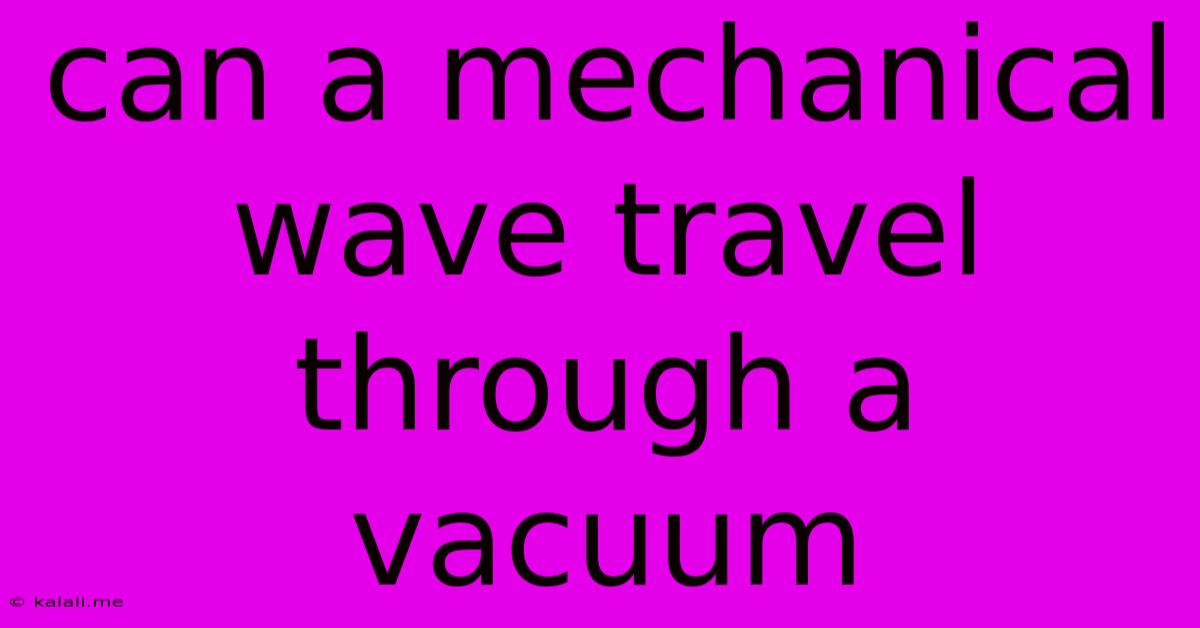Can A Mechanical Wave Travel Through A Vacuum
Kalali
Jun 06, 2025 · 2 min read

Table of Contents
Can a Mechanical Wave Travel Through a Vacuum?
Meta Description: Discover the fascinating world of wave propagation! This article explores whether mechanical waves, like sound, can travel through a vacuum, and explains the crucial role of a medium in their transmission.
Mechanical waves, unlike their electromagnetic counterparts, require a medium to propagate. This means they cannot travel through a vacuum. Let's delve deeper into why.
Understanding Mechanical Waves
Mechanical waves are disturbances that travel through a medium by transferring energy from one particle to another. Think of a ripple in a pond: the water molecules don't travel across the pond, but the energy of the disturbance does, causing a wave to propagate. Examples include sound waves, water waves, and seismic waves. These waves rely on the physical interaction between particles within the medium to transmit their energy.
The Role of the Medium
The medium provides the pathway for the energy transfer. The particles in the medium oscillate—they move back and forth or up and down—as the wave passes through. These oscillations are what transfer the energy. The properties of the medium, such as density and elasticity, directly influence the speed and characteristics of the mechanical wave.
Why Vacuum Prevents Propagation
A vacuum, by definition, is devoid of matter. There are no particles for the wave to interact with and transfer its energy. Without a medium to oscillate and transmit the disturbance, the mechanical wave cannot propagate. This is why you can't hear sounds in the vacuum of space.
Contrasting with Electromagnetic Waves
This contrasts sharply with electromagnetic waves, such as light and radio waves. Electromagnetic waves are self-propagating and do not require a medium. They consist of oscillating electric and magnetic fields that can travel through a vacuum, as demonstrated by sunlight reaching Earth.
Examples illustrating the need for a medium:
- Sound in air: Sound waves are longitudinal mechanical waves that require air molecules to vibrate and transmit sound. In a vacuum chamber, a bell would produce no audible sound.
- Seismic waves in the Earth: Earthquakes generate seismic waves that travel through the Earth's layers (solid, liquid, and gaseous). The speed and characteristics of these waves depend on the properties of these layers.
- Water waves: Ocean waves are a type of surface wave that propagates across the water's surface. If there were no water, there would be no waves.
Conclusion
In summary, mechanical waves cannot travel through a vacuum. Their propagation depends entirely on the presence of a medium to facilitate the transfer of energy through particle oscillations. Understanding this fundamental difference between mechanical and electromagnetic waves is crucial to grasping the behavior of various types of waves in different environments.
Latest Posts
Latest Posts
-
Sex Outside Of Marriage Is A Sin
Jun 07, 2025
-
Do The Work Of An Evangelist
Jun 07, 2025
-
Does A Blocked Shot Count As A Shot Attempt
Jun 07, 2025
-
How To Access Steam Cloud Saves
Jun 07, 2025
-
What Chapter Is The Last Episode Of Jjk
Jun 07, 2025
Related Post
Thank you for visiting our website which covers about Can A Mechanical Wave Travel Through A Vacuum . We hope the information provided has been useful to you. Feel free to contact us if you have any questions or need further assistance. See you next time and don't miss to bookmark.